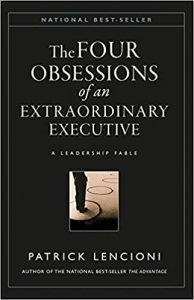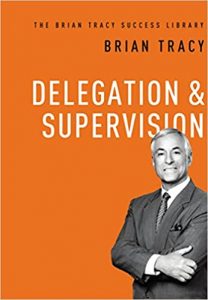I am a huge fan of business parables. When done right, they are a more enjoyable way to read about a business methodology or framework.
Patrick Lencioni did it right with the four obsessions. I enjoyed reading the story of two executives who are running similar firms with different approaches.
The methodology that is being taught is very simple in theory but hard to execute. If the 4 obsessions were presented in the start of the book it would have needed a lot of examples, data, and context to really make it hit home.
Instead Lencioni uses a fictitious story to each and give credibility to his thoughts and ideas.
I would recommend this book to any leader who is struggling to get his leadership team to communicate, make decisions quickly, and use their vision and mission statement at the core of every big decision they make.
The Four Obsessions
- Build and maintain a cohesive leadership team
- Create organizational clarity
- Over-communicate organizational clarity
- Reinforce organizational clarity through human systems
How to build and maintain a cohesive leadership team
Lencioni’s story highlights the importance of building trust and truly getting to know each leader’s personality and style of leadership. Building a cohesive leadership team means that everyone can respectfully voice their opinion and everyone will seek clarity for the organization.
How do you access your team for cohesiveness?
- Are meetings compelling? Are the important issues being discussed during meetings?
- Do team members engage in unguarded debate? Do they honestly confront one another?
- Do team members apologize if they get out of line? Do they ever get out of line?
- Do team members understand one another?
- Do team members avoid gossiping about one another?
Create organizational clarity
This is making sure everyone is clear on the vision + mission + core values of the company. Talk about them often and filter all of your thoughts, ideas, and decisions through them to make sure everyone is on the same page.
I loved the section of the book where it talks about thematic goals, major strategic goals, and metrics. Most employees aren’t overly excited by metrics but want to know where the company is going and how they can be a part of it. These thematic goals should be communicated every chance you get.
Here is what you need to share to create organizational clarity
- Why the organization exists
- Which behavioral values are fundamental
- What specific business it is in
- Who it’s competitors are
- How it is unique
- What it plans to achieve
- Who is responsible for what
Over-communicate organizational clarity
Within companies that effectively over-communicate, employees at all levels and in all departments understand what the organization is about and how they contribute to its success.
Page 166
It’s difficult for leaders to reiterate the same message over and over. I know I struggle with this and once I get it in my head figure it’s easy to just transfer the knowledge to someone else. But we underestimate the importance of context, timing, and how people learn, etc.
Here is how you should be over-communicating to your organization
- Repetition – don’t be afraid to repeat the same message again and again.
- Simplicity – The more complicated the message, the more potential for confusion and inconsistency
- Multiple Mediums – people react to information in many ways; use a variety of mediums.
- Cascading Messages – leaders communicate key messages to direct reports; the cycle repeats itself until the message is heard by all.
Reinforce organizational clarity through human systems
Communication alone won’t create organizational clarity. In order to reinforce clarity throughout the organization it needs to be built into systems and process.
The example Lencioni gives in the book is how the successful executive relentlessly hires based on the core values of the company.
There are 4 primary systems that must reinforce clarity
- Hiring – do you hire on core values and who can help advance the strategic objectives of the company?
- Managing performance – do you measure performance against core values as well as the ability to work well within the team to promote organizational clarity?
- Rewards and recognition – how do you reinforce behavior? Healthy organizations eliminate as much subjectivity as possible by using consistent criteria for rewards and recognition.
- Employee transitions (firing) – healthy organizations use their core values and team’s trust to quickly make decisions when someone isn’t a fit for the organization and remove them so as not to harm the organization’s momentum.
Biggest Insights
I have 2 big insights from this book.
- Most team members don’t care about metrics as much as the leadership team. Communicate thematic goals instead.
- Meetings should have leaders challenging other leaders and pushing each other for organizational clarity
Join The Newsletter
Get occasional emails from me when I publish new projects and articles.



